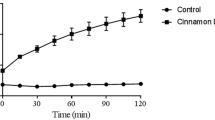Abstract
Data from our previous studies suggested that the fungal cell wall component, chitin, is involved in the adhesion of Candida albicans to mucosal surfaces. In the present study, we investigated the effect of polyoxin D, an inhibitor of chitin synthase, on the interaction of the fungus with epithelial cells. The effect of polyoxin D on Candida was evaluated in in vitro assays for its capacity to adhere to buccal epithelial cells (BEC), and by fluorescent-microscopy photometry and flow cytometry using cells stained with cellufluor (CF), a fluorochrome with affinity for chitin. C. albicans grown with and without polyoxin D was stained with CF and examined in a fluorescent microscope equipped with a photometer. Measurements of fluorescence revealed a wide range of intensity among C. albicans cells and a decreased intensity in polyoxin D treated cultures. Flow cytometry analyses of yeasts revealed 2 peaks of fluorescence intensity, and pointed to differences between polyoxin D treated and non-treated microorganisms. C. albicans stained with CF were separated into 2 subpopulations by flow cytometry according to fluorescence intensity. In vitro adhesion of each subpopulation to BEC was similar. Polyoxin D treated fungi showed significantly reduced adherence to BEC, as evaluated by a radioactivity assay with radiolabelled yeasts and by microscopic readings. The reduction in adhesion was Polyoxin D concentration dependent. These observations support our previous findings suggesting involvement of chitin in the attachment process of C. albicans (CBS562) to epithelial cells.
Similar content being viewed by others
References
Douglas LJ. Adhesion of Candida species to epithelial surfaces. CRC Critic Rev Microbiol 1987; 15: 27–43.
Rotrosen D, Calderone RA, Edwards JE. Adherence of Candida albicans to host tissues and plastic surfaces. Rev Infect Dis 1986; 8: 73–85.
Segal E. Pathogenesis of human mycoses: role of adhesion to host surfaces. Microbiol Sci 1987; 4: 344–47.
Kreger-van Rij NJW. Classification of yeasts. In: Rose AH, Harrison JS, eds. The Yeasts, Vol. I. London, New York, Tokyo: Academic Press, 1987: 5–61.
McCourtie J, Douglas LJ. Extracellular polymer of Candida albicans: isolation, analysis and role in adhesion. J Gen Microbiol 1985; 131: 495–503.
Sandin RL, Rogers AL, Patterson RJ, Beneke ES. Evidence for mannose mediated adherence of Candida albicans to human buccal cells in vitro, Infect Immun 1982; 35: 79–85.
Kahana M, Segal E, Schewach Millet M, Gov Y. In vitro adherence of Candida albicans to human corneocytes: inhibition by chitin soluble extract. Act Derm Venerol 1985; 68: 98–101.
Lehrer N, Segal E, Barr-Nea L. In vitro and in vivo adherence of Candida albicans to mucosal surfaces. Annal Microbiol (Inst. Pasteur) 1983; 134B: 293–306.
Lehrer N, Segal E, Lis H, Gov Y. Effect of Candida cell wall components of the adhesion of the fungus to human and murine vaginal mucosa. Mycopathologia 1988; 102: 115–21.
Sandovsky-Losica H, Segal E. Interaction of Candida albicans with murine gastrointestinal mucosa: effect of irradiation on adherence in vitro. J Med Vet Mycol 1989; 27: 345–52.
Segal E, Savage DC. Adhesion of Candida albicans to mouse intestinal mucosa in vitro: development of the assay and test of inhibitors. J Med Vet Mycol 1986; 24: 477–79.
Segal E, Lehrer N, Ofek I. Adherence of Candida albicans to human vaginal epithelial cells: inhibition by amino sugars. Exp Cell Biol 1982; 50: 13–17.
Segal E, Gottfried L, Lehrer N. Candidal vaginitis in hormone treated mice: prevention by a chitin extract. Mycopathol 1988: 102; 157–63.
Farkas V. Biosynthesis of cell walls of fungi. Microbiol Rev 1979; 43: 117–44.
Shepherd MG. Cell envelope of Candida albicans. CRC Crit Rev Microbiol 1987; 15: 7–25.
Tronchin, G, Poulain D, Herbaut J, Biguet J. Localization of chitin in the cell wall of Candida albicans by means of wheat germ agglutinin: fluorescence and ultrastructural studies. Eur J Cell Biol 1981; 26: 121–28.
Orleans P. Two chitin synthases in Saccharomyces cerevisiae. J Biol Chem 1987; 12: 5732–739.
Au-Young J, Robbins PW. Isolation of a chitin synthase gene (CHS1) from Candida albicans by expression in Saccharomyces cerevisiae. Mol Microbiol 1990; 4: 197–207.
Becker JM, Covert NL, Sheubagamurthi P, Steinfeld A, Naider F. Polyoxin D inhibits growth of zoopathogenic fungi. Antimicrob Agents Chemother 1983; 23: 926–29.
Chiew YY, Shepherd MG, Sullivan PA. Regulation of chitin synthesis during germ tube formation in Candida albicans. Arch Microbiol 1980; 125: 97–104.
Hilenski L, Naider F, Becker JM. Polyoxin D inhibits colloidal gold-wheat germ agglutinin labelling of chitin in dimorphic forms of Candida albicans. J Gen Microbiol. 1986; 132: 1441–451.
Calderone R, Lehrer N, Segal E. Adherence of Candida albicans to buccal and vaginal epithelial cells: ultrastructural observations. Can J Microbiol 1984; 30: 1001–7.
King RD, Lee JA, Morris AL. Adherence of Candida albicans and other Candida species to mucosal epithelial cells. Infect Immun 1980; 27: 667–74.
Suegara N, Segal JE, Savage, DC. Ecological determinants in microbial colonization of the murine tract: adherence of Torulopsis pintolopesii to epithelial surfaces. Infect Immun 1979; 25: 139–45.
Hayashibe M, Kathoda S. Initiation of budding and chitin ring. J. Gen Appl Microbiol 1973; 19: 23–39.
Herth W. Calcofluor white and congo red inhibit chitin microfibril assembly of Poteriochromonias: evidence for a gap between polymerization and microfibril formation. J Cell Biol 1980; 87: 442–50.
Maeda H, Ishida N. Specificity of binding of hexopyranosyl polysaccharides with fluorescent brightness. J Biochem 1967; 62: 276–278.
Foster RF, Kaufman SJ. Cell surface events during myogenesis; Immunofluorescence analysis using monoclonal antibodies. In: Reid E, Cook GMW, and Moore DJ, eds. Investigation and exploitation of antibody combining sites. New York: Plenum Publishing Corp., 1985: 167–75.
Braun PC, Hector RF, Kamark ME, Hart JT, Cihlar RL. Effect of cerulenin and sodium butyrate on chitin synthesis in Candida albicans. Can J Microbiol 1987; 33: 546–50.
Kennedy MJ, Sandin RL. Influence of growth condition on Candida albicans adhesion, hydrophobicity and cell wall ultrastructure. J Med Vet Mycol 1988; 26: 79–92.
Ofek I, Simpson WA, Beachey EH. Formation of molecular complexes between structurally defined M protein and actylated or deacylated lipoteichoic acid of Streptococcus pyogenes. J. Bacteriol 1982; 149: 426–433.
Kennedy MJ. Adhesion and association mechanisms of Candida albicans. Current Topics in Medical Mycology 1988; 2: 73–169.
Christensen GD, Simpson WA, Beachey EH. Adhesion of bacteria to animal tissues, complex mechanism. In: Savage DC, Fletcher M eds. Bacterial adhesion mechanisms and physiological significance. New York-London: Plenum Press, 1985; 279–305.
Duguid JP, Old C. Adhesive properties of enterobacteriaceae. In: Beachey EH, ed. Bacterial adherence, receptors and recognition. London: Chapman and Hall, 1980: 187–217.
Critchley IA, Douglas LJ. Role of glycosides as epithelial cell receptors for Candida albicans. J Gen Microbiol 1987; 133: 637–45.
Kennedy MJ, Rogers AL, Hanselman LR, Soll DR, Yan-cey RJ. Variation in adhesion and cell surface hydrophobicity in Candida albicans white and opaque phenotypes. Mycopathol 1988; 102; 149–56.
Clancy J, Savage DC. Another colicin V phenotype: in vitro adhesion of Escherichia coli to mouse intestinal epithelium. Infect Immun 1981; 32: 343–52.
Lee JC, King RD. Characterization of Candida albicans adherence to human vaginal epithelial cells in vitro. Infect Immun 1983; 41: 1024–30.
Author information
Authors and Affiliations
Rights and permissions
About this article
Cite this article
Gottlieb, S., Altboum, Z., Savage, D.C. et al. Adhesion of Candida albicans to epithelial cells effect of polyoxin D. Mycopathologia 115, 197–205 (1991). https://doi.org/10.1007/BF00462227
Received:
Accepted:
Issue Date:
DOI: https://doi.org/10.1007/BF00462227




